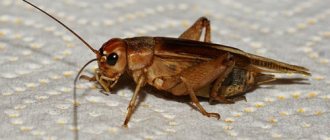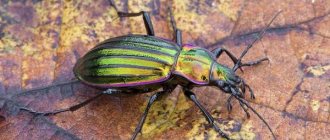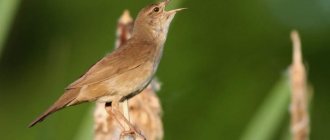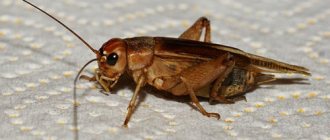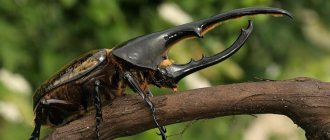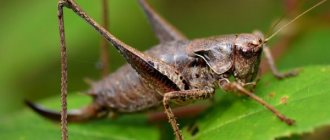Who are crickets and what do they look like?
Crickets: singing neighbors.
Name: True crickets Lat.:
GryllidaeClass: Insects - Insecta Order: Orthoptera - Orthoptera
| Habitats: | garden |
| Dangerous for: | herbs, vegetables, small insects |
| Struggle: | prevention, deterrence |
Representatives of the species
Crickets, like grasshoppers or locusts, belong to the order of Orthoptera insects. The most famous representatives of the cricket family are the house cricket and the field cricket.
Corpuscle
Insects have a fairly powerful body, the length of which can reach from 1.5 to 2.5 cm. The body color of various species can be from bright yellow to dark brown.
Wings
At the end of the cricket's body there are two characteristic thread-like processes. The wings of some species are very well developed and are used for flight, while in others they can be completely reduced.
Head
The head has a spherical shape, slightly flattened in front. In the frontal part of the cricket's head there are three simple single-faceted eyes. The insect's mouthparts are located at the bottom of the head.
Structure
The house cricket's body is slender and cylindrical; covered with a chitinous shell, which reduces moisture loss and protects the insect from mechanical damage. The ears are located in the lower legs of the front legs. The female has a long ovipositor (11-15 mm) at the end of her body, with which she drills into the soil to lay eggs. The forewings of male crickets are shorter than those of females; The cerci are long in both sexes. The wings are well developed; at rest, the hind wings are folded longitudinally, their tips extending beyond the end of the back of the head. Although the house cricket is capable of flight, it flies extremely rarely and only at high temperatures.
How crickets sing
Cricket.
The so-called “singing” of crickets is actually a sonic way of communicating with the opposite sex. Males that have reached sexual maturity are able to make special loud sounds to attract females. They do this thanks to the friction of the elytra.
For this purpose, on one of the crickets’ elytra there is a chirping cord, and on the other there are special teeth. When these organs interact, insects reproduce sounds familiar to humans.
Crickets can also use their “songs” to scare off other male competitors.
Why do grasshoppers chirp?
In most cases, you can only hear a cricket chirping at night. That's when the musicians come out of their holes. Although in country fields you can enjoy the trill at any time of the day. During mating games, insects can play music both day and night. Silencing an Orthoptera is very easy. He stops singing as soon as he senses danger. Therefore, at the slightest approach to him, the male hides in a hole.
The simplicity of the grasshopper's acoustic organ prevents them from chirping at night. At this time, dew falls in the grass and the wet organ is not able to emit trills. The sound of the green insect can only be heard during the daytime.
In Japan, little musicians are especially respected. They are bred specifically to be able to listen to melodious ringing at any time.
No, not only. Females, depending on their desire, can also sometimes begin to chirp, but basically such “music playing” is the lot of males.
Crickets and grasshoppers instantly stop chirping in moments of danger.
The membranes of crickets are thinner than those of grasshoppers, so the sounds they make are more melodic and varied. Each insect has its own sound frequency (from 3.6 to 4 kilohertz).
The chirping of a grasshopper resembles a sharp crackling sound, gentle, sometimes quieter, sometimes louder. It seems that the grasshoppers persistently and sharply “break” dry grass and stems. In fact, grasshoppers rub their front or hind legs against each other or against their wings, which are equipped with bristles. The bristles are quite hard, so there is a cracking sound that is so familiar to every person.
Only males can chatter. These are their mating songs. They attract and fascinate females with their “charming” sounds. Females do not need this, so they simply do not have the “tools” for cod.
When danger approaches, grasshoppers instantly fall silent. This saves the grasshoppers from real enemies. That's why, when you walk through a field, meadow or clearing in a park, you don't hear grasshoppers nearby. But if you stand still and remain motionless for at least a few minutes, you will be rewarded with the choral singing of all the males in the area.
It is not easy to spot a grasshopper in the grass. If they jump, you will see their bodies flashing in the grass. They adapt to the surrounding grass on which they feed. Therefore, they come in green, brown-green, brown colors.
But if you stand for a minute without moving, the owners of the meadows and fields will begin to choose convenient places on your body. Some will jump on your shoes, while others will reach your shoulder. The higher you are, the better you can see.
True, grasshoppers do not use sight, but they have perfect hearing. Don't scare off the guest, try to look at him carefully. And if a male jumps on you, then you will examine his entire “musical” instrument.
It has been proven that the sound of a grasshopper has a beneficial effect on the human nervous system. It is monotonous, not intrusive and rhythmic. If nothing distracts you, then after listening to the chirping for about five minutes, you will no longer distinguish it from other sounds of the surrounding nature. And you will hear the music of nature, which will free you from unnecessary stress and cleanse you from the sounds and voices of the city. Refreshed, you return to your business.
Materials
Progress
results
Why?
These are the most common “chirpers”. Grasshoppers live almost throughout the entire territory of Russia, except for the highlands and regions of the Far North. Most species are hunters, patiently waiting for prey to appear. In this respect, the grasshopper is similar to a praying mantis - it also lies in wait for its prey, and then grabs it with its strong front legs and powerful jaws.
Sometimes a grasshopper moves with quiet steps, feeling the road in front of it with its antennae - as soon as it touches another insect, the hunter catches it with a quick swoop. When choosing an object for a snack, he does not disdain anyone, even his relatives. Most often, aphids, hairless caterpillars, young beetles and fillies are found in its jaws.
So it turns out that the children’s song is not telling the truth: the grasshopper will “touch” the grasshopper and the booger, and is not particularly friendly with flies. And, by the way, it can easily bite the skin on the fingers of a person who carelessly grabs it. Moreover, he will vomit a drop of his own blood into the wound, which will burn like fire. Handle him with care!
The grasshopper has long whiskers (sometimes 4 times longer than the body), while the locust has short whiskers. The female grasshopper has a saber-shaped ovipositor at the end of its abdomen, but the locust does not. The grasshopper has a pointed head at the bottom and a short body for greater maneuverability. The locust has a rounded and blunt head, and an elongated body for better aerodynamics. Grasshoppers are sedentary, while swarms of locusts fly thousands of kilometers.
Habitat of crickets
The habitat of representatives of the cricket family covers almost the entire world, but the most favorable conditions for them are high humidity and warmth. The greatest diversity of species of these insects is observed in the following regions:
- Africa;
- Mediterranean;
- South America.
A cricket near his house.
In addition, you can find it in:
- North America;
- Asia;
- Europe.
On the territory of mainland Australia, the insect lives only in one southern city - Adelaide.
Birds
We enrich and activate our vocabulary.
We consolidate knowledge of nouns: birds, rook, stork, lark, starling, swift, wagtail, goose, duck, crane, drake, nightingale, swallow, cuckoo, sparrow, bullfinch, crossbill, tit, pigeon, crow, jackdaw, woodpecker, feeding trough, food, body, paw, tail, wing, beak, head, feathers, egg, nest, chick, hunger, cold, bread crumbs, grain, rowan, care, help, human habitation, owl; verbs: jump, fly, sweep, flap, sit, starve, feed, pour, steal, tweet, croak, coo, crack, hollow, treat, drag away, hibernate; adjectives: black, agile, white-sided, motley, blue-winged, grey, perky, cheerful, hungry, wintering; adverbs: hungry, cold, pitiful, high, low, little, far, close. We monitor the correct use of prepositions in speech: WITH, ON, ABOVE, TO, FROM, UNDER, FROM UNDER, NEAR, ABOUT.
Lifestyle of crickets
Crickets are fairly heat-loving insects and their main activity in temperate climates occurs in the warm season. A drop in air temperature below 21 degrees Celsius makes crickets sluggish and inactive.
It was in search of shelter from the cold that some species of crickets settled near humans.
As soon as the average daily air temperature begins to drop, people encounter these “singing” neighbors in rooms such as:
- residential buildings;
The cricket is shedding.
- garages;
- agricultural buildings;
- heated warehouses;
- industrial building.
In their natural environment, crickets are also always in search of shelter. They hide under stones, in cracks or holes.
Signs of the presence of bedbugs in the house
It is hardly possible to detect insects as soon as they appear. Linen bugs are nocturnal hunters. During the day they hide in furniture, mattresses, and cracks in walls. At night, the parasites go out hunting, accurately determining by thermal radiation where the prey is located.
Often the insect moves along the ceiling, hovering above the sleeping person in bed and falling from there onto the skin. At first, when a person sees a bite in the morning, he thinks that he was bitten by a mosquito. When the population has grown, it is no longer possible not to notice the aliens.
The main signs of bed bugs appearing in a house:
- the bites are not single, but form a trail of small wounds;
- around the bug puncture on the skin a swelling forms with a lump in the center;
- toxins injected by insects into the blood of a sleeping person cause a typical allergic reaction in the form of burning and itching;
- Tiny blood stains often remain on the bed;
- places where insects accumulate (often under wallpaper on the walls) are contaminated with their excrement in the form of microscopic black dots;
- Pests can also be detected by the remains of the quinine coating, which they shed during molting;
- bedbugs have a specific smell - some call it cognac, while others think it is the aroma of rotten raspberries.
What do crickets eat?
These insects are practically omnivorous and adapt well to environmental conditions.
Their diet in the wild may consist of:
- herbs;
- green leaves;
- young shoots;
- small insects;
- corpses of other animals;
- oviposition and insect larvae.
He can enjoy eating at home:
- bread crumbs;
- droplets of drinks or liquid dishes;
- leftover fruits and vegetables;
- fish and meat waste;
- flies or any other small invertebrates found in the house.
It is worth noting that, just like grasshoppers, crickets, if necessary, can undoubtedly feast on their fellow creatures or destroy the egg-laying eggs of their own species.
Causes of chirping
Crickets
The main reason why you can hear crickets chirping is because of their breeding habits. In this way, a sexually mature male tries to attract a female. Its rubbing can continue from dawn to dusk until the cry is heard. The success of the process will largely depend on the strength of the male’s sound; the more energetic, melodic and sonorous he is, the greater the chance of attracting a female.
You can hear a cricket sing not only if it wants to reproduce. Insects lead an isolated lifestyle and occupy several square centimeters. The site is carefully guarded by its owner and does not allow guests except the female. He walks around his property several times a day and checks the integrity of the territory.
Interesting!
The chirping is intended to scare away uninvited guests and warn about the belligerent attitude of the owner of the site.
A person enjoys listening to crickets, regardless of the reason for these sounds. Their trill is as melodious as the singing of birds, so some even prefer to breed Orthoptera representatives at home. This is not difficult to do, and optimism is fueled by the fact that in captivity singers can chirp not only at night, but also during the day.
Why are crickets dangerous?
Cricket.
Despite the melodious “singing” of crickets, they are not as harmless as they seem. If a lot of these insects have settled in a summer cottage, they can pose a serious threat to the future harvest.
In comfortable conditions, the number of crickets can increase quite quickly and for food they will most likely prefer juicy, young seedlings in the garden beds instead of weeds. Do not forget that with the onset of autumn, insects will move into the house, and such a pleasant evening “singing” for the ears can turn into a nightmare that does not allow you to fall asleep.
It is necessary to control the cricket population, especially when they have inhabited the entire area and are a threat. There are 9 real ways to get rid of it.
Built-in violin
The grasshopper performs incredibly beautiful melodies using its front wings. The grasshopper moves the jagged vein on the left wing, like a bow, along the “grater” on the right wing, and from it the vibrations are transmitted to a special vibrating membrane, the “mirror.”
The performer’s “track list” includes long, piercing invocation songs, short trills of warning to rivals, and a quiet, creaky ballad addressed to the lady of his heart. The male not only plays it - sometimes he also dances, swaying from side to side while performing.
The hearing organs of grasshoppers are located... on the shins of the front legs.
The inside of the “ears” are very complex, but on the outside they look like membranes or narrow slits. We suggest you read: How to drive a cricket out of the house
Classification
As of June 2022, the genus includes 20 species:
- Locustella accentor (Sharpe, 1888) [syn. Bradypterus accentor
] – Kinabal speckled breast - Locustella alfredi (Hartlaub, 1890) [syn. Bradypterus alfredi
] - Bamboo variegated - Locustella alishanensis (Rasmussen, Round, Dickinson & Rozendaal, 2000)
- Locustella castanea (Büttikofer, 1893) [syn. Bradypterus castaneus
] - Moluccan pied beetle - Locustella caudata (Ogilvie-Grant, 1895) [syn. Bradypterus caudatus
] - Long-tailed Pied-breasted - Locustella chengi Alström et al., 2015
- Locustella davidi (La Touche, 1923)
- Locustella fluviatilis (Wolf, 1810) - River cricket
- Locustella idonea (Riley, 1940)
- Locustella kashmirensis (Sushkin, 1925)
- Locustella lanceolata (Temminck, 1840) - Spotted cricket
- Locustella luscinioides (Savi, 1824) - Nightingale cricket
- Locustella luteoventris (Hodgson, 1845) [syn. Bradypterus luteoventris
] - Brown variegated breast - Locustella major (W.E. Brooks, 1871) [syn. Bradypterus major
] - Long-billed warbler, or long-billed warbler - Locustella mandelli (W. E. Brooks, 1875)
- Locustella montis (Hartert, 1896)
- Locustella naevia (Boddaert, 1783) - Common cricket
- Locustella seebohmi (Ogilvie-Grant, 1895) [syn. Bradypterus seebohmi
] - Mountain mottled beetle - Locustella tacsanowskia Swinhoe, 1871 - Siberian mottled warbler, or Tachanovsky's warbler
- Locustella thoracica (Blyth, 1845) [syn. Bradypterus thoracicus
]
In 2022, as a result of phylogenetic studies, 6 species were allocated to the genus Helopsaltes Alström et al., 2022:
- Helopsaltes amnicola (Stepanyan, 1972) [syn. Locustella amnicola
] - Sakhalin cricket - Helopsaltes certhiola (Pallas, 1811) [syn. Locustella certhiola
] - Song cricket - Helopsaltes fasciolatus (GR Gray, 1861) [syn. Locustella fasciolata
] - Taiga cricket - Helopsaltes ochotensis (Middendorff, 1853) [syn. Locustella ochotensis
] - Okhotsk cricket - Helopsaltes pleskei (Taczanowski, 1890) [syn. Locustella pleskei
] - Island cricket - Helopsaltes pryeri (Seebohm, 1884) [syn. Locustella pryeri
] - Japanese cricket, or Japanese warbler, or Japanese long-tailed warbler
Good omens
According to signs, with its singing, a cricket protects the house it has chosen to live in. In rural areas this is common, but in city apartments it is rare. So city residents can regard the appearance of a musical insect not as a mere accident, but as a sign of fate.
- Hearing crickets at home on the eve of Christmas is a sign of sudden profit. The only Russian sign associated with crickets that promises material benefits.
- For sick people, seeing or hearing a cricket means a speedy recovery. Especially if the cricket has settled in the very room where the sick family member is resting. In case of serious illnesses, a green cricket, a symbol of hope, is a particularly good sign.
- The chirping of a cricket behind the stove (in the case of modern houses and apartments, the stove) can be interpreted as a sign of good luck. But this is not the only interpretation; for another, see below.
Family well-being
The cricket’s favorite “area of activity” is intra-family relationships, the strength of bonds and the prosperity of the social unit.
- The cricket starts up and sings songs in the room of an unmarried girl or a single boy - for an imminent wedding. This is not necessarily a good omen, because many value their freedom and do not intend to get married. But for men eager to get married (as well as their parents, who are still waiting for their son to start his own family) and women in search of a relationship, crickets in the house promise a happy fulfillment of matrimonial desires.
- For pregnant women, the cricket predicts good health for the rest of the term, an easy birth and the birth of a healthy baby. Just what a twitchy woman in position needs.
- For widows, crickets predict that the pain of loss will soon subside. According to some beliefs, a cricket is the embodiment of the soul of a deceased spouse, who came to visit his wife and protect her sleep with his nightly songs. But crickets are of no use to widowers.
- If a cricket suddenly stops chirping at night and starts chirping during the day, this portends that one of the household members will leave the house. Not necessarily forever, but for a long time. Previously, this interpretation was much more sinister, because the integrity of the family was determined by one house, but now the omen can also be regarded as a good sign: in the case of adult children who are still not going to move out.
Sounds of music
Any chirping by grasshoppers is not just for fun, but for a specific purpose. Most often, males attract females in this way. But scientists were able to find out that the different structure of the elytra is determined not only by the type of insect, but also by some features of its life and behavior. So, for example, those species of Orthoptera that chirp in tall grass, which can be an obstacle to the propagation of a sound signal, have a wider range of sound frequencies. This is necessary to increase immunity to interference. But species that chirp in flight make do well with a narrower frequency range - after all, in open space, sound travels very far.
